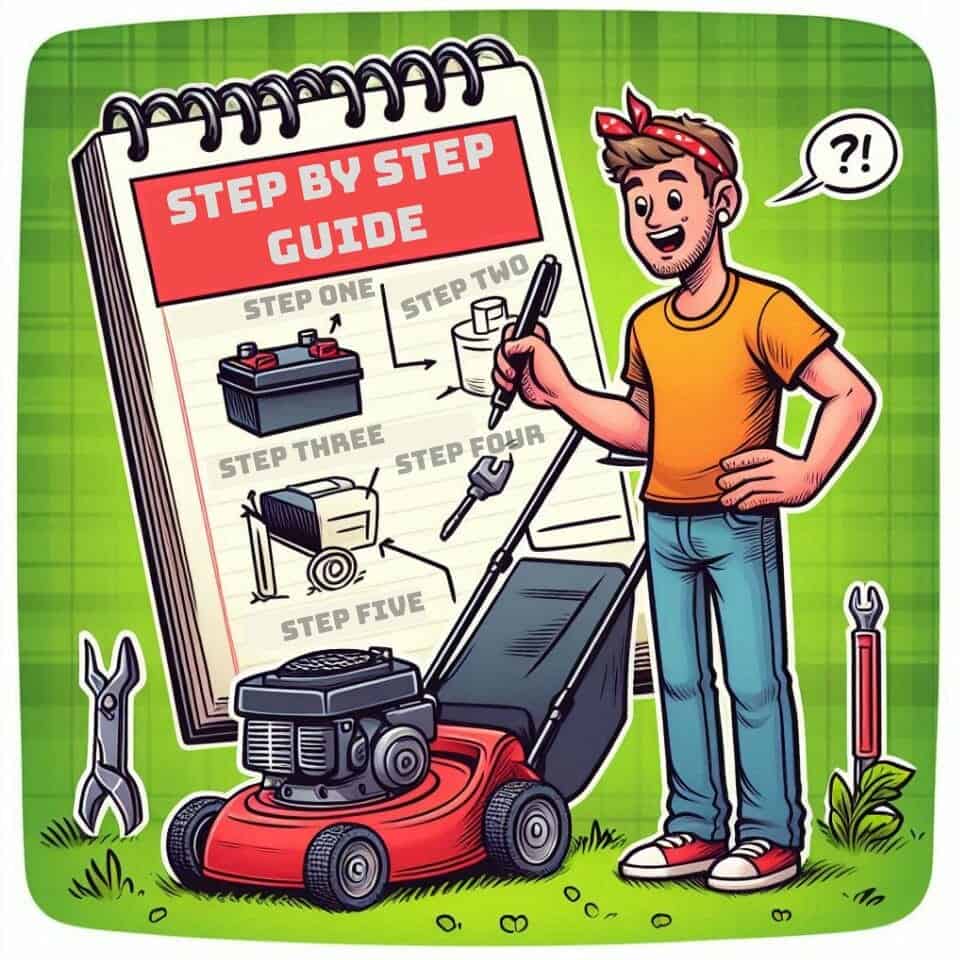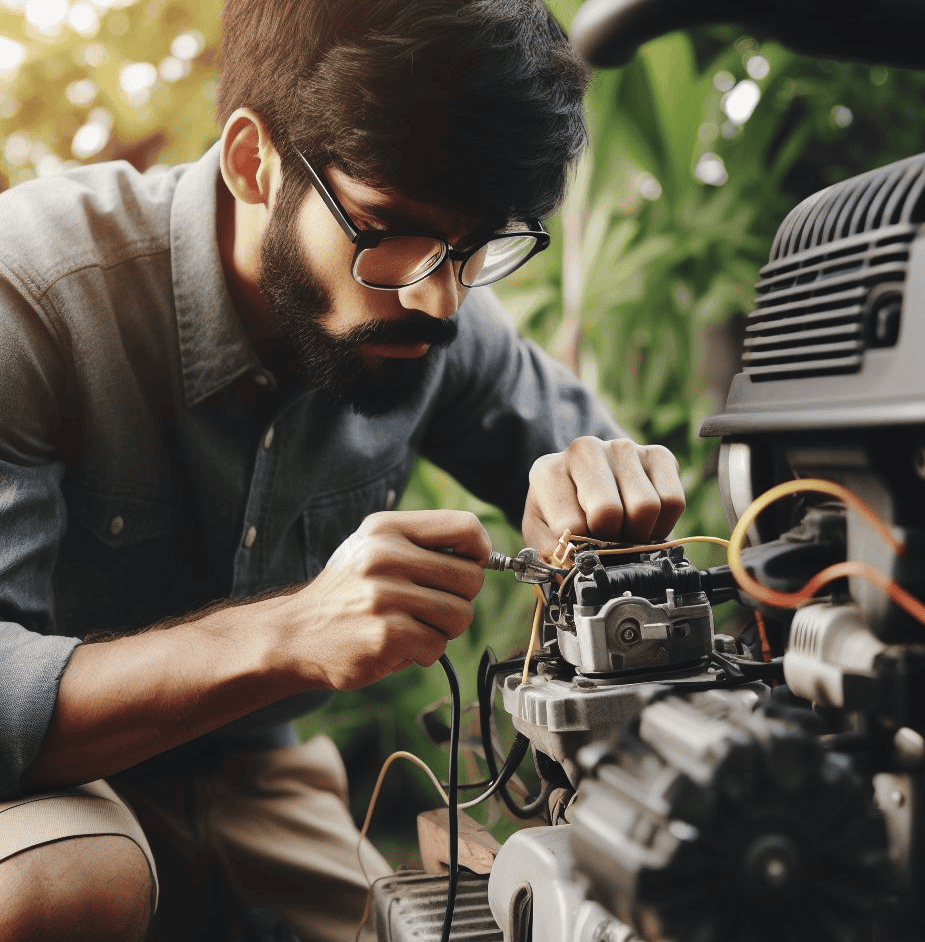A functioning lawn mower battery is key to maintaining a healthy lawn. Without it, even the most well-maintained mower won’t start, leaving your grass to grow wild and untamed. Replacing a lawn mower battery might seem daunting, but knowing how to replace a lawn mower battery can save you time and frustration.
Proper maintenance and timely replacement of your lawn mower battery can help avoid issues such as decreased runtime or difficulty starting the mower. Regular upkeep ensures that your mower operates efficiently, prolonging the battery’s lifespan and enhancing overall yard health.
Key Steps to Follow:
- Locate and access the battery compartment.
- Remove the old battery.
- Prepare the new battery.
- Install the new battery securely.
- Test and finalize to ensure everything is in order.
Embracing these steps helps maintain your lawn mower in peak condition, saving you money on professional repairs.
Regularly maintaining your lawn mower battery not only keeps your equipment running smoothly but also contributes to achieving a lush, well-maintained lawn. Ready to tackle this task? Let’s dive into the step-by-step guide for replacing a lawn mower battery.
But before we get started, if you have other household appliances giving you trouble, such as a stuck garbage disposal, we have you covered with a guide on that too.
Tools Needed for Replacing a Lawn Mower Battery
When it comes to replacing a lawn mower battery, having the right tools on hand can make the process much easier and smoother. Whether you’re a DIY enthusiast or simply want to troubleshoot any battery issues, here are the essential tools you’ll need:
1. Wrench
A wrench is a must-have tool for loosening the battery connectors. It allows you to remove the old battery and replace it with a new one without any hassle. Make sure to choose a wrench that is suitable for your specific lawn mower model.
2. Wire Brush
Corrosion is a common problem that can affect the performance of your lawn mower battery. A wire brush comes in handy for cleaning any corrosion present on the battery terminals. By scrubbing away the buildup, you ensure a proper and secure connection for your new battery.
Having these essential tools readily available will save you time and effort when it’s time to replace your lawn mower battery. Ensure you have them in your toolbox before starting the battery replacement process.
| Tools | Function |
|---|---|
| Wrench | Loosens battery connectors for easy removal |
| Wire Brush | Cleans corrosion from battery terminals |

Step-by-Step Guide: How to Replace a Lawn Mower Battery
Step 1: Locating and Accessing the Battery
Before you start replacing your lawn mower battery, it’s important to know where it’s located. The exact placement can vary depending on the make and model of your mower. Here are some general steps to help you find and access the battery:
For Riding Lawn Mowers:
- Under the Seat: Check underneath the seat of your mower. In many cases, the battery is located here.
- Beneath the Hood: If you don’t find the battery under the seat, look for it under the hood of your mower.
- Accessing the Battery: Once you’ve located the battery, you may need to lift the seat or open a panel to reach it.
For Push Lawn Mowers:
- Check the Deck: On electric push mowers, the battery is usually housed in a compartment on the deck.
- Near the Handle: In some cases, you might find the battery located near the handle of your push mower.
To safely access the battery compartment:
- Turn Off the Mower: Make sure your lawn mower is turned off and parked on a flat surface. If there’s a key, remove it to prevent any accidental starts.
- Engage Safety Mechanisms: If your mower has safety features like a brake or lever lock, activate them.
- Gather Your Tools: Get any necessary tools such as screwdrivers or wrenches that you’ll need to open panels or compartments.
Step 2: Removing the Old Battery
Before we get into the details of lawn mower battery replacement, let’s first understand the overall process:
- Locating and accessing the battery
- Removing the old battery
- Preparing the new battery
- Installing the new battery
- Testing to finalize the setup
Removing the old battery is a critical step in this process. Here’s how you can do it:
1. Disconnecting the Battery Cables:
- Start by disconnecting the negative (-) terminal first. This is important for safety reasons as it helps prevent any accidental short circuits.
- Use a wrench or pliers to loosen the nut on the negative terminal and carefully remove the cable. It’s a good idea to tuck this cable away from the battery to avoid any contact while you’re working on the positive terminal.
- Next, disconnect the positive (+) terminal in a similar manner.
2. Removing the Battery from its Holder:
- Once both cables are disconnected, look for any retaining straps or brackets that are holding the battery in place.
- Carefully unfasten these securing mechanisms. Depending on your lawn mower model, this could involve loosening screws or unclipping straps.
- Gently lift and remove the old battery from its holder.
Now that you’ve successfully removed your old battery, you’re ready to prepare and install your new one.
Step 3: Preparing the New Battery
Preparing the new battery is a crucial step in the lawn mower battery replacement process. Before installing the new battery, it’s essential to ensure it’s ready for use. Here are some key points to consider:
Inspect the Battery for Damage or Defects
- Before proceeding with the installation, take a moment to carefully inspect the new battery. Look for any visible damage, such as cracks or leaks, and check that the terminals are in good condition. A damaged battery can cause issues down the line and may even be unsafe to use.
Charge the Battery if Necessary
- Some batteries come pre-charged, while others might require charging before use. Refer to the manufacturer’s instructions to determine if your new battery needs an initial charge. If charging is required:
- Use a compatible charger and follow safety guidelines.
- Charge the battery to its full capacity to ensure optimal performance.
Ensuring your new battery is free from defects and fully charged sets you up for a smooth installation process, helping you avoid potential setbacks.
Step 4: Installing the New Battery
After preparing the new battery, the next step is to install it securely in your lawn mower. This process involves placing the battery correctly and reconnecting the cables.
Guide to Securely Install the New Battery:
- Positioning the Battery: First, place the new battery into the holder or tray where the old battery was located. Ensure that it is seated properly and aligned with the terminals facing the correct direction.
- Securing the Battery: Use any clamps or straps that were holding the old battery in place to secure the new one. This prevents movement and ensures stability during operation.
Reconnecting the Battery Cables:
- Positive Terminal First: Start by connecting the red cable to the positive (+) terminal of the battery. This is crucial as it helps avoid accidental short circuits.
- Negative Terminal Next: Next, attach the black cable to the negative (-) terminal. Make sure both connections are tight and secure to prevent any loss of power or connectivity issues.
Taking these steps ensures a smooth and safe installation process for your lawn mower battery replacement.
Once your new battery is installed and all connections are secure, you’re ready to move on to testing and finalizing your setup in Step 5.
Step 5: Testing and Finalizing the Installation
After you’ve successfully installed the new battery, it’s important to test everything to make sure it’s working correctly. This will help prevent any future problems. Here are the steps to follow:
| Step Number | Step Title | Description |
|---|---|---|
| 1 | Test the Battery Voltage | Use a multimeter to check the voltage of the new battery. This will ensure that it meets the manufacturer’s requirements and give you peace of mind knowing that your lawn mower will run smoothly. Set your multimeter to measure DC voltage, then connect the probes to the battery terminals (positive to positive, negative to negative). A fully charged 12-volt battery should read around 12.6 volts. |
| 2 | Double-Check Connections | Take another look at all the connections to make sure they are tight and in the correct positions. Make sure both the positive (+) and negative (-) terminals are securely attached. Check for any loose wires or corrosion at the connection points. |
| 3 | Secure the Battery | Confirm that the battery is firmly held in place by its holder or tray. This will prevent it from moving around while you’re using the lawn mower, which could cause connections to come loose or damage to occur. |
| 4 | Do a Test Run | Start up your lawn mower and see if it powers on without any problems. |
If it starts up easily, then congratulations! You’ve successfully finished replacing your lawn mower’s battery.
When working with electrical parts like this, it’s always a good idea to be extra careful and double-check everything. Just like how you would follow a detailed guide on how to fix a printer that won’t print, making sure your lawn mower’s battery is installed correctly can save you from unexpected issues.
Tips for Maintaining a Healthy Lawn Mower Battery
Regular maintenance is key to ensuring the longevity and performance of your lawn mower battery. Here are some practical tips to keep your battery in top shape:
1. Keep the Battery Clean and Terminals Corrosion-Free
Regularly inspect your battery for dirt, debris, and corrosion. Use a mixture of baking soda and water to clean the terminals, then rinse with water and dry thoroughly. This helps maintain optimal electrical conductivity and prevents poor connections.
2. Safe Charging Practices
Always charge your battery according to the manufacturer’s instructions. Overcharging or undercharging can significantly reduce the battery’s lifespan. Investing in a smart charger can help manage charging cycles efficiently, ensuring that your battery remains at optimal capacity.
3. Proper Storage During Inactivity
When storing your lawn mower for extended periods, such as during winter, it’s essential to store the battery correctly. Fully charge the battery before storage and keep it in a cool, dry place. Disconnect the terminals to prevent any potential drain on the battery. If possible, use a trickle charger to maintain the charge level.
Maintaining your lawn mower battery not only extends its life but ensures your mower runs smoothly when you need it most.
Taking these steps keeps your lawn mower ready for action and helps avoid unexpected interruptions during your mowing routine.
Signs of a Failing Battery and Troubleshooting Tips
Identifying a failing lawn mower battery promptly can save you time and effort. Common signs indicating a problem with the battery’s health include:
- Decreased Runtime: If your lawn mower runs out of juice quicker than usual, it could be a sign that the battery is losing its capacity.
- Difficulty Starting: Struggling to start your mower? This often points to a weakening battery unable to hold a sufficient charge.
- Dim or Flickering Lights: For mowers equipped with lights, dimming or flickering can signal battery issues.

Initial Troubleshooting Steps
Before rushing to replace your lawn mower battery, consider these troubleshooting steps:
- Check for Loose ConnectionsInspect the battery terminals and ensure they are tightly connected.
- Look for any signs of corrosion, which can impede electrical flow. Cleaning them might resolve the issue.
- Test the Battery VoltageUse a multimeter to check the battery voltage. A fully charged lawn mower battery typically reads around 12.6 volts or higher.
- If the reading is significantly lower, it indicates that the battery is not holding a charge properly.
- Inspect the Battery for DamageLook for visible signs of damage such as cracks or leaks. Physical damage can compromise the battery’s performance and safety.
Following these steps can help determine whether the issue lies with the battery itself or another component of your lawn mower.
For those facing more complex problems, it may be worth consulting our detailed guides on related maintenance tasks like cleaning a lawn mower carburetor, which might also affect your mower’s performance. Additionally, if you happen to have pen ink stains on your clothes while working on your lawn mower, we have a helpful guide on how to remove pen ink from clothes that you might find useful.
Identifying and addressing these issues early ensures your lawn mower remains in optimal condition, ready for action when you need it most.
When to Seek Professional Help
In some cases, the guidance provided in this article may not be enough to resolve your lawn mower battery issues. For complex problems or if your mower is still under warranty, seeking professional assistance might be the best course of action. Here are a few scenarios where reaching out to a professional lawn mower repair service can save you time and prevent further damage:
- Complex Electrical Issues: If the problem goes beyond a simple battery replacement and involves intricate electrical components, it’s wise to consult an expert. Attempting to fix these on your own could lead to more severe issues.
- Warranty Concerns: If your lawn mower is still under warranty, tampering with the battery or other parts could void it. Always check your warranty terms and consider professional service options covered by the manufacturer.
- Persistent Problems: Sometimes, even after replacing the battery, issues like difficulty starting or inconsistent performance persist. These problems might indicate underlying issues that require a professional diagnosis.
- Safety Concerns: Working with batteries involves handling potentially hazardous materials and electrical components. If you’re not comfortable performing the replacement yourself, it’s safer to hire a professional.
For assistance with other household fixes, such as dealing with laptop overheating or fixing a broken doorknob, check out our detailed guides at FixedandSolved.com.
Understanding when to call in a professional can prevent unnecessary stress and ensure your lawn mower operates smoothly.
Final Thoughts
Proper battery maintenance and prompt replacement are essential for keeping your lawn mower running smoothly. A well-maintained battery ensures that your mower starts effortlessly and operates efficiently, allowing you to achieve a lush and well-maintained lawn. By following the step-by-step guide provided in this article, you can confidently replace your own lawn mower battery. This not only saves you time but also helps you avoid the costs associated with professional repairs.
The process might seem daunting at first, but with careful attention to each step, it becomes a manageable task. A healthy battery is more than just a convenience; it’s a vital component of your overall yard care routine. Keeping your battery in top shape contributes significantly to your lawn’s health.

Michael Miller is a gardening enthusiast with a green thumb and a knack for fixing anything related to the world of plants. He envisions owning a vineyard in the future, a testament to his deep love for cultivation. Happily married with two kids in vibrant Tokyo, Japan, Michael’s life is a blend of botanical beauty and family bonds. Join him on his journey where gardening passion meets a vision for the future, and explore the secrets of cultivating a harmonious life.


